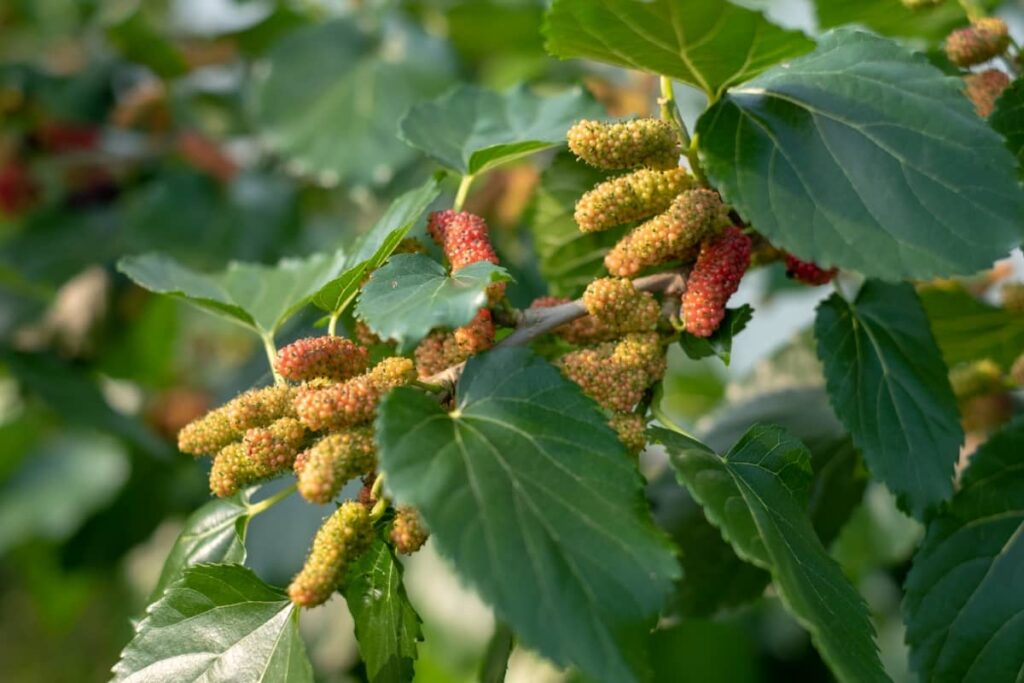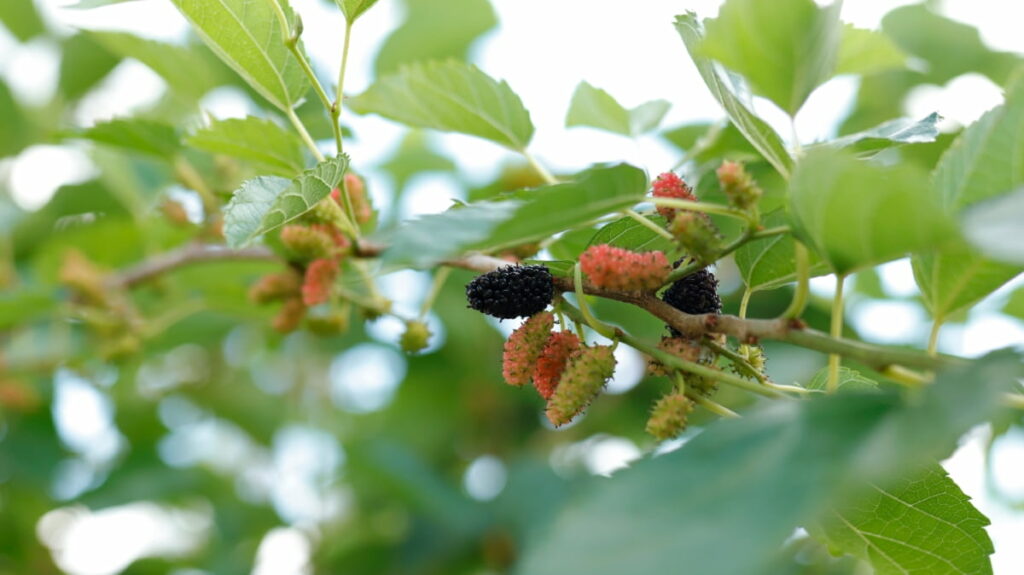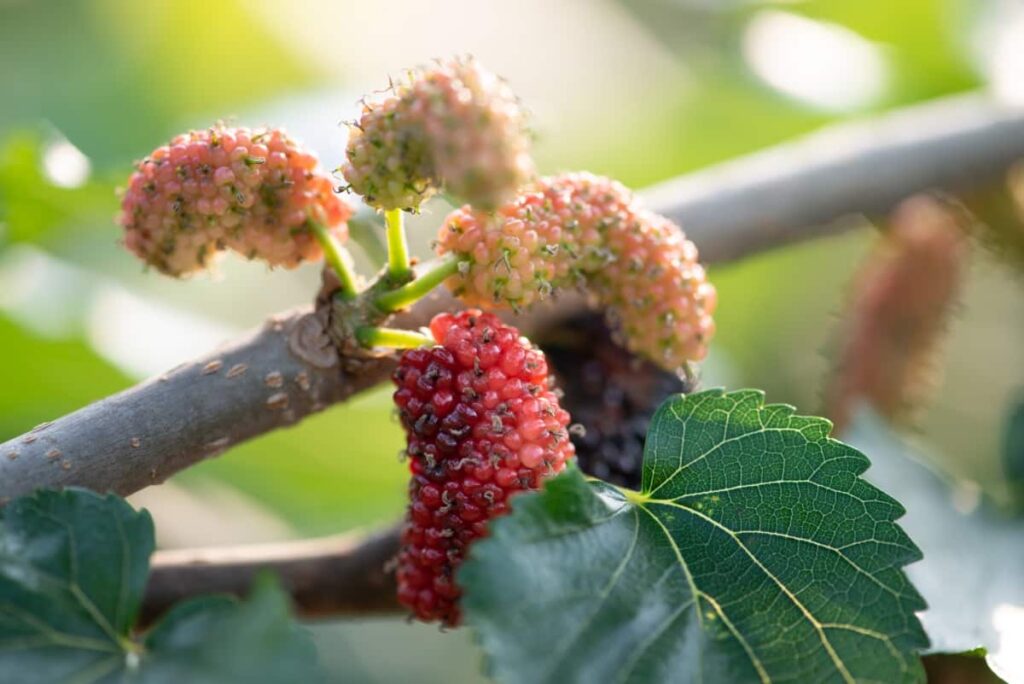Pruning promotes healthy growth by removing dead or diseased branches, improving airflow, and enhancing sunlight penetration. It shapes the tree’s structure, stimulates fruit production, and prevents hazards such as falling branches.

Weeping Mulberry Pruning
Best Time for Pruning
The ideal time for pruning weeping mulberry trees is during late winter or spring when the tree is in dormancy. This drives optimal healing and reduces the disease transmission risk. Avoid pruning during periods of active growth to minimize stress on the tree.
Understanding the Weeping Mulberry Growth Habits
Growth Characteristics
Weeping mulberries exhibit a graceful, cascading growth habit with slender, pendulous branches that sweep downward. They grow up to 15 feet tall and wide, forming a dense, umbrella-like canopy. The foliage is deciduous, with deep green lobed leaves that turn yellow in autumn.
Identifying Different Parts of the Tree
The weeping mulberry tree comprises several identifiable parts. Its trunk is the main upright stem from which branches emerge. Branches form the canopy, consisting of smaller twigs and leaves. The leaves are typically heart-shaped with serrated edges, while the fruit, when present, resembles small, cylindrical blackberries.
Tools and Preparation for Pruning
Selecting the Right Tools
Choose high-quality pruning tools for mulberries appropriate for the size and type of branches on your weeping mulberry tree. Essential tools include hand pruners for smaller branches, loppers for thicker branches, and a pruning saw for larger limbs. Ensure blades are sharp to make clean cuts and reduce the risk of injury to the tree.
Preparing Your Tools for Pruning
Before starting, clean and disinfect your pruning tools to prevent the disease’s spread between cuts. Inspect blades for damage and sharpen as needed. Lubricate moving parts to ensure smooth operation. Check handles for cracks or damage and replace them if necessary to maintain a secure grip and prevent accidents during pruning.
Safety Equipment
Wear appropriate safety gear like gloves to shield hands from scratches and thorns, safety glasses to prevent eye injuries from flying debris, A sturdy footwear with good traction to avoid slips or falls. If pruning large branches overhead, consider using a helmet for additional head protection.
Initial Pruning of Young Trees
Establishing a Strong Framework
For pruning Young Mulberry trees, begin by identifying the central leader, which should be the main trunk of the weeping mulberry tree. Select 3-4 strong lateral branches evenly spaced around the trunk to serve as scaffold branches. Remove any competing leaders or branches that grow inward or downward. Aim to create a well-balanced framework that will support the tree’s growth.
Training for Desired Shape
Prune the selected scaffold branches to an outward-facing bud or lateral branch, encouraging horizontal growth and preventing overcrowding within the canopy. Shape the tree as per your desired form, whether it’s a single-trunked specimen or a multi-stemmed tree. Regularly monitor growth and adjust pruning as needed to maintain the desired shape and structure.
Maintenance Pruning of Mature Trees
Thinning for Light and Air Circulation
Regularly thin the canopy of mature weeping mulberry trees to improve light penetration and airflow. Thinning promotes even distribution of sunlight and reduces the risk of fungal diseases by allowing good air circulation throughout the canopy.
Removing Dead or Diseased Wood
Inspect the tree annually for dead, diseased, or damaged branches and promptly remove them to maintain the tree’s health and appearance. Dead wood can harbor pests and pathogens, while diseased branches can spread infections to the remaining parts of the tree.
In case you missed it: Strawberry Growing Information Guide

Pruning for Fruit Production
Encouraging Fruitful Branches
Focus pruning efforts on promoting the growth of fruit-bearing branches on the weeping mulberry tree. Identify and retain vigorous, outward-facing branches that are capable of bearing fruit. Remove weak, crowded, or excessively shaded branches that are unlikely to produce high-quality fruit. Encourage lateral branching by pruning to outward-facing buds, which stimulates the development of fruiting spurs.
Timing and Techniques for Maximizing Yield
Prune weeping mulberry trees during late winter or early spring, prior to the new growth begins, to maximize fruit production. Use techniques such as thinning cuts to remove overcrowded branches and stimulate the growth of new fruiting wood. Additionally, perform rejuvenation pruning every few years to remove older, less productive wood and encourage the development of new fruiting spurs. Regular pruning helps maintain the tree’s vigor and ensures consistent yields of high-quality fruit.
Seasonal Pruning Practices
Winter Pruning for Structure
Perform winter pruning on weeping mulberry trees to focus on shaping and enhancing the tree’s structure. During the dormant season, typically from late winter to early spring, prune to establish a strong framework by removing any crossing, rubbing, or inward-growing branches. This helps maintain an open canopy, promotes airflow, and reduces the risk of damage from snow or ice accumulation.
Summer Pruning to Control Growth
In summer, conduct pruning to control the growth of the weeping mulberry tree and maintain its desired size and shape. Remove any excessive or unwanted growth, including water sprouts and suckers, to redirect the tree’s energy towards fruit production and overall health. Summer pruning also helps manage the canopy density, allowing better sunlight penetration and air circulation to the inner branches.
Dealing with Common Pruning Challenges
Overgrown Trees
As overgrown Mulberry pruning techniques, start by removing dead, damaged, or diseased wood, then selectively thin out crowded branches to improve light and airflow. Follow up with strategic pruning to reduce the overall size and reshape the canopy. Don’t remove more than one-third of the tree’s foliage in a single pruning session to prevent shock.
Water Sprouts and Suckers
Promptly remove these growths as they divert energy away from fruit production and detract from the tree’s aesthetic appeal. Use sharp pruning shears for clean cuts flush with the parent branch or trunk. Regular monitoring and pruning are essential to prevent the proliferation of water sprouts and suckers.
Post-Pruning Care
Wound Treatment and Protection
After pruning, it’s essential to properly treat and protect wounds to aid in the tree’s healing process and prevent diseases or pests from entering through open cuts. A thin layer of pruning sealant or wound dressing should be applied to larger cuts to create a protective barrier against pathogens and environmental stressors. Avoid excessive use of wound dressings, as they may trap moisture and inhibit healing.
Fertilization and Watering Needs After Pruning
Following pruning, adjust the tree’s fertilization and watering regimen to support its recovery and stimulate new growth. Apply a balanced fertilizer around the tree’s drip line, following package instructions for dosage and timing. Water the tree deeply and regularly, especially during periods of drought or hot weather, to ensure adequate moisture uptake and root health.
In case you missed it: How to Start Blueberry Farming in India: Varieties, Yield, Cost, and Profit Per Acre

Note: The images presented in this post are intended solely for representation purposes. The images are meant to serve as visual aids and should not be relied upon as accurate representations of their real-life counterparts.
Conclusion
Mastering pruning techniques for weeping mulberry trees is essential for promoting their health, appearance, and fruit production. With careful attention to seasonal mulberry tree care, seasonal pruning, post-pruning mulberry care, and addressing common challenges, beginners can confidently nurture flourishing weeping mulberry trees for years to come.
- Aquaponic Farming at Home: A Step-By-Step Guide
- Profitable Village Farming Business Ideas in 2024
- High-Yield Aquaculture: Fast-Growing Fish for Farming
- Effective Fish Pond Construction Techniques for Beginners
- Irrigation and Water Management in Pineapple Farming
- Blossom to Harvest: Mastering Flowering and Pollination in Papaya Farming
- Pig Fattening Essentials: From Selection to Sale for Beginners
- Raising Wagyu Cattle: A Complete Guide for Premium Beef Production
- Soil Types and Their Water Holding Capacity
